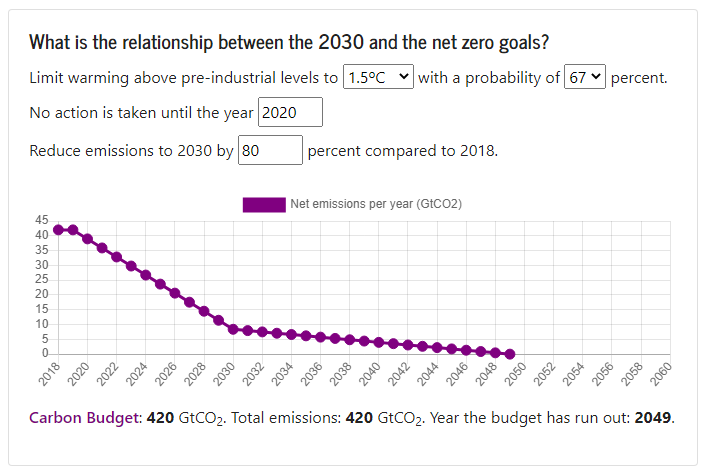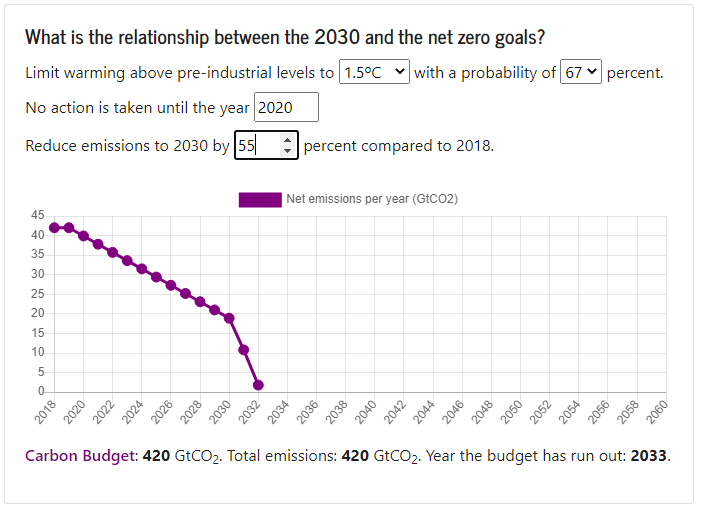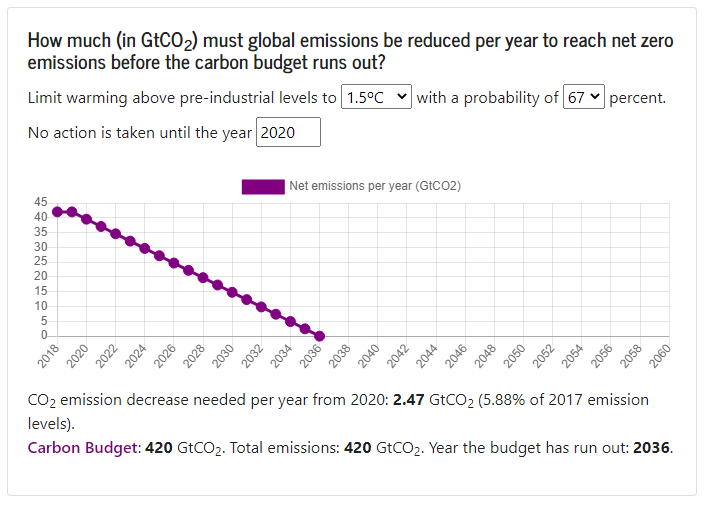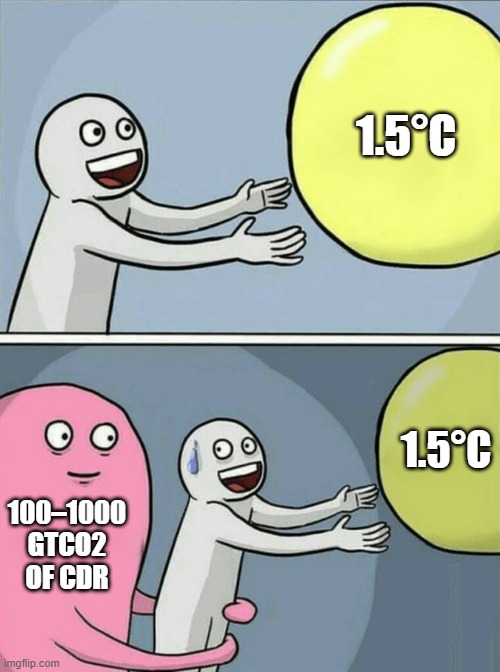"Halving emission by 2030 and achieving net zero by 2050 will get us to the 1.5°C ambition" is a dangerous myth, and it is unfortunately spreading all over the place. 1/
This comes from the @IPCC_CH SR15 report from 2018, which in the SPM C.1 stated that "In model pathways with no or limited overshoot of 1.5°C, global net anthropogenic CO2 emissions decline by about 45% from 2010 levels by 2030 [...], reaching net zero around 2050 [...]" 2/
HOWEVER: Section C.3 is then clearly states that "All pathways that limit global warming to 1.5°C with limited or no overshoot project the use of carbon dioxide removal (CDR) on the order of 100–1000 GtCO2 over the 21st century". That's a LOT to remove! 3/
If we assume that 500 GtCO2 of removal is needed and we assume that we start removing it in 2050, it means that 10GtCO2 needs to be removed every year. In other words, it means removing about 1/4 of what we currently emit today, every year from 2050 to 2100! 4/
It would require massive amounts of land use (BECCS), energy and water (DAC), and there are many other huge issues as well, such as who's land will be used, who will pay for it, and on and on. We just don't know yet how to do it. 5/
If we don't want to assume that we can do removal of CO2 on a massive scale after 2050 (we don't want to assume that), we need to look at what the carbon budget (also from the SR15 report) allows. 6/
If we want to skip requiring removal of 100–1000 GtCO2 over the 21st century and keep the net-zero 2050 date, we must reduce emissions by 80 percent in 2030. (Source: carbonbudgetcalculator.com) 7/ 

If we want to skip requiring removal of 100–1000 GtCO2 over the 21st century and keep the "reduce 50% by 2030", the whole budget runs out by 2030! But, if we reduce by 55% by 2030, we will need to reach net zero by 2033. 8/ 

So in summary we have three actual options for 1.5°C:
1. Reduce CO2 ~50% by 2030, net zero 2050, AND REMOVE ~10-100 GtCO2 BEFORE 2100😵
2. Reduce CO2 by 80%(!) 2030, reach net zero 2050, and stay at zero😌
3. Reduce CO2 by 55% 2030, reach net zero 2033(!), and stay at zero😌 9/
1. Reduce CO2 ~50% by 2030, net zero 2050, AND REMOVE ~10-100 GtCO2 BEFORE 2100😵
2. Reduce CO2 by 80%(!) 2030, reach net zero 2050, and stay at zero😌
3. Reduce CO2 by 55% 2030, reach net zero 2033(!), and stay at zero😌 9/
PLEASE NOTE that "Halving emission by 2030 and achieving net zero by 2050, and chill" IS NOT ONE OF THE OPTIONS! 10/
So, who is spreading this "halve by 2030, net zero 2050" myth?
@sciencetargets (@CDP, @globalcompact, @WRIClimate, @WWF, @WMBtweets) recently released a new report on net-zero targets in the corporate sector.
sciencebasedtargets.org/wp-content/upl…
It's a great report, well worth a read. 11/
@sciencetargets (@CDP, @globalcompact, @WRIClimate, @WWF, @WMBtweets) recently released a new report on net-zero targets in the corporate sector.
sciencebasedtargets.org/wp-content/upl…
It's a great report, well worth a read. 11/
It states in the executive summary (p. 5) that "[IPCC] confirmed that in order to limit global warming to 1.5°C, the world needs to halve CO2 emissions by around 2030 and reach net-zero CO2 emissions by mid-century.", and FORGETS about all the carbon removal needed to 2100! 12/
It moves on to state in "Guiding Principle 2" (p. 20) that "companies should transition towards net-zero in line with mitigation pathways that are consistent with limiting warming to 1.5°C with no or limited overshoot", and FORGETS AGAIN all the carbon removal needed to 2100. 13/
Which means that the companies will have a "science-based" net zero goal, based on the flawed premise that that when a company has reaching net zero they have done enough, when SR15 clearly states that that is not the case! Still need to remove massive amounts of CO2! 14/
Another example; Race to Zero (unfccc.int/climate-action…) (@UNFCCC) has the same issue in their criteria for participation (unfccc.int/sites/default/…) 15/
It states that participants should "Set an interim target to achieve in the next decade, which reflects a fair share of the 50% global reduction in CO2 by 2030 identified in the IPCC Special Report on Global Warming of 1.5C" 16/
Participants should also set a net zero target to 2050 or earlier, and they are all set. OH NO, WE FORGOT TO MENTION THE 10-100 GtCO2 TO BE REMOVED FROM THE ATMOSHPHERE BEFORE 2100, AGAIN! 😫 17/
The same issue also applies to countries, e.g. the Swedish climate law, which has a net zero date, but no specific goals related to net negative emissions after reaching net zero. 18/
Or the EU, which has set a net zero by 2050 goal, and might want to reduce 55% by 2030 (compared to 1990), but also has nothing on negative emissions after 2050. 19/
Or probably all other inadequate NDCs out there, which also might have a net zero date in the best case scenario, but will never (as far as I know) contain any specific goals around net negative after that. (If I'm wrong let me know!) 20/
So in summary: Whenever anyone tells you "halve by 2030 and net zero by 2050, and 1.5°C is all set!" you should just ask them politely
"AND WHAT ABOUT THE ON THE ORDER OF 100–1000 GtCO2 TO BE REMOVED DURING THE 21st CENTURY, DID YOU FORGOT ABOUT THAT HUH!?!?!?!?" 21/
"AND WHAT ABOUT THE ON THE ORDER OF 100–1000 GtCO2 TO BE REMOVED DURING THE 21st CENTURY, DID YOU FORGOT ABOUT THAT HUH!?!?!?!?" 21/
I feel like this was made worse by a couple of poor choices in SR15:
1. 100–1000 GtCO2 of carbon dioxide removal was not in the same statement as "45% by 2030" and "net zero 2050". If it was in the same sentence, maybe people would have paid attention. 23/
1. 100–1000 GtCO2 of carbon dioxide removal was not in the same statement as "45% by 2030" and "net zero 2050". If it was in the same sentence, maybe people would have paid attention. 23/
2. IPCC could have stated a single number for carbon dioxide removal instead of the "on the order of 100–1000", which is vague. If it would have been less vague, maybe it would have been taken seriously.
But maybe people just want to ignore it, and it wouldn't have mattered. 24/
But maybe people just want to ignore it, and it wouldn't have mattered. 24/
(This has all been said before by people more competent than me, such as @KevinClimate. This is just my take on it.) 25/
Maybe it would have helped if the IPCC would just have continued with the percentages after 2050 as well? Something like "Reduce 50% by 2030, 100% by 2050, 125% by 2070, and 130% by 2100."
Might have been easier to translate into action for countries, companies et cetera. 26/
Might have been easier to translate into action for countries, companies et cetera. 26/
For completeness: If we want to skip requiring removal of 100–1000 GtCO2 over the 21st century and ignore both the 50% by 2030 and the net zero by 2050 goals and assume a linear reduction, we need to reach net zero by 2036. (carbonbudgetcalculator.com) 27/ 

Errata: In tweets 9 and 17 of this thread I incorrectly wrote 10-100 GtCO2, when it should have said 100-1000 GtCO2. Sorry about that! (And thanks @HjalmarNowak for pointing this out to me) 28/
For more on carbon budgets, see this thread by @hausfath which explains a few more details on them, and shows emission pathways for 50%/66% 1.5°C/2.0°C budgets from the IPCC SR15. (It is the 66% 1.5°C budget I'm using in all examples above.) 29/
https://twitter.com/hausfath/status/1309191498018164736
As usual when it comes to climate, this is a question of AND, not OR. There is a need to
1. Set much more ambitious emission reduction goals, so that we do not require 100-1000 GtCO2 of carbon removal before 2100 (since we don’t know if we can do it)
AND...
1. Set much more ambitious emission reduction goals, so that we do not require 100-1000 GtCO2 of carbon removal before 2100 (since we don’t know if we can do it)
AND...
...AND
2. Invest in researching and scaling up sustainable carbon dioxide removal technologies, both technology based AND nature based solutions to be able to remove 100-1000 GtCO2 before 2100 (since it will for sure help reaching our climate goals, no matter what goal we set)
2. Invest in researching and scaling up sustainable carbon dioxide removal technologies, both technology based AND nature based solutions to be able to remove 100-1000 GtCO2 before 2100 (since it will for sure help reaching our climate goals, no matter what goal we set)
• • •
Missing some Tweet in this thread? You can try to
force a refresh





